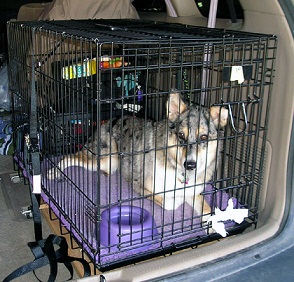
A crate can look like a jail cell to you or I, but when used properly it will act as your dogs den which will be completely natural to him a personal space where he can feel safe, secure and comfortable. The best place to locate a crate would be where your dog can see family members hear and smell your house - the kitchen is usually a great spot but each house may vary.
An ideal crate will be large enough to allow your dog to stretch out, stand without bumping his head and be able to turn around in. The crate should not be large enough so that your dog can relieve himself in one corner and move away to play and sleep in another. If your puppy is young and is not fully grown, try to block off a portion of the crate with cardboards or wood boards, this will allow you to purchase a larger crate instead of several smaller ones to fit your puppy as he grows.
To encourage your dog to “enjoy” his new den, you should equip it with soft beddings (maybe some towels or an old blanket of your own), a bowl of water and a toy that he likes. (It is often a good idea to remove the water at night when you are potty training your dog).
When introducing the idea of a crate to your dog you must introduce it slowly. Crate him in small intervals, lasting about 10 minutes, and gradually increase over time. Your dog will need time to get used to being crated. Never crate him for more than 30 minutes the first time, as this could cause him to associate the crate with a punishment.
It is not advisable to crate a young puppy for a long period of time no more than two hours is a good rule of thumb and your pup should always be exercised before being crated.
Its quite normal for dogs to fuss, bark and moan while in the crate. If these things happen, do not give your dog any attention! Eventually he will settle down, if you give him attention it will encourage him to bark and whimper every time he goes in the crate.
* If its a young puppy whom youve just introduce the crate to, offering him a treat in the crate to calm him down will sometimes work. Whatever you do, dont let him out of the crate at that very moment, allow him to stay in for his 10 minutes or so.*
Lastly, dog should not be crated for too long day after day. Your dog may develop destructive behaviors and anxiety problems. If you notice that your dog displays hyper active behavior which is different than before, you might be crating him for too long!
The most important thing of all is that you should never ever punish your dog in the crate, if you do so he will always dread going back to the crate. It is meant to be a comfortable and safe space, not a place for punishment, doing so will only lengthen the time it takes to crate train and could even make crate training impossible.




